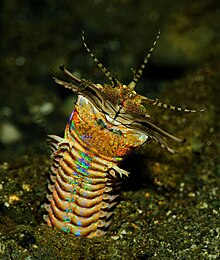| Eunicidae Temporal range:
| |
|---|---|

| |
| Eunice aphroditois | |
| Scientific classification | |
| Domain: | Eukaryota |
| Kingdom: | Animalia |
| Phylum: | Annelida |
| Clade: | Pleistoannelida |
| Subclass: | Errantia |
| Order: | Eunicida |
| Family: | Eunicidae Berthold, 1827 |
| Genera | |
|
See text | |



Eunicidae is a family of marine polychaetes (bristle worms). The family comprises marine annelids distributed in diverse benthic habitats across Oceania, Europe, South America, North America, Asia and Africa.[1] The Eunicid anatomy typically consists of a pair of appendages near the mouth (mandibles) and complex sets of muscular structures on the head (maxillae) in an eversible pharynx.[2] One of the most conspicuous of the eunicids is the giant, dark-purple, iridescent "Bobbit worm" (Eunice aphroditois), a bristle worm found at low tide under boulders on southern Australian shores. Its robust, muscular body can be as long as 2 m.[3] Eunicidae jaws are known from as far back as Ordovician sediments.[4][5] Cultural tradition surrounds Palola worm (Palola viridis) reproductive cycles in the South Pacific Islands.[6] Eunicidae are economically valuable as bait in both recreational and commercial fishing.[7][8] Commercial bait-farming of Eunicidae can have adverse ecological impacts.[9] Bait-farming can deplete worm and associated fauna population numbers,[10] damage local intertidal environments [11] and introduce alien species to local aquatic ecosystems.[12]
In 2020, Zanol et al. stated, "Species traditionally considered to belong to Eunice are now, also, distributed in two other genera Leodice and Nicidion recently resurrected to reconcile Eunicidae taxonomy with its phylogenetic hypothesis."[13]
- ^ Rouse, G. W; Pleijel, F. (2001). "ROUSE, G. W. & PLEIJEL, F. 2001. Polychaetes. Xiii + 354 pp. Oxford: Oxford University Press. Price £109.50. ISBN 0 19 850608 2". Geological Magazine. 140 (5). Oxford: Oxford University Press: 617–618. doi:10.1017/S0016756803278341. S2CID 86760716.
- ^ Fauchald, K; Jumars, P. A. (1979). "The Diet of Worms: A Study of Polychaete Feeding Guilds". Oceanography and Marine Biology: An Annual Review. 17. Aberdeen University Press: 193–284.
- ^ Keith Davey (2000). "Eunice aphroditois". Life on Australian Seashores. Retrieved 2007-10-10.
- ^ Fauchald, K. (1992). "A review of the genus Eunice (Polychaeta: Eunicidae) based upon type material" (PDF). Smithsonian Contributions to Zoology. 523 (523): 1–422. doi:10.5479/si.00810282.523.
- ^ Parry, Luke; Tanner, Alastair; Vinther, Jakob (2015). "The Origin of Annelids". Palaeontology. 57 (6). The Palaeontological Association: 1091–1103. doi:10.1111/pala.12129.
- ^ Schulze, Anja; Timm, Laura E. (2011). "Palolo and un: distinct clades in the genus Palola (Eunicidae, Polychaeta)". Marine Biodiversity. 42 (2): 161–171. doi:10.1007/s12526-011-0100-5. ISSN 1867-1616. S2CID 12617958.
- ^ Gambi, M. C.; Castelli, A.; Giangrande, A.; Lanera, P.; Prevedelli, D.; Zunarelli Vandini, R. (1994). "Polychaetes of Commercial and Applied Interest in Italy: An Overview". Mémoires du Muséum National d'Histoire Naturelle. 162: 593–603.
- ^ Olive, P. J. W. (1994). "Polychaeta as a World Resource: A Review of Patterns of Exploitation as Sea Angling Baits, and Potential for Aquaculture Based Production". Mémoires du Muséum National d'Histoire Naturelle. 162: 603–610.
- ^ Cite error: The named reference
:12was invoked but never defined (see the help page). - ^ Cite error: The named reference
:17was invoked but never defined (see the help page). - ^ Cite error: The named reference
:18was invoked but never defined (see the help page). - ^ Cite error: The named reference
:14was invoked but never defined (see the help page). - ^ Zanol, Joana; Hutchings, Pat A.; Fauchald, Kristian (5 March 2020). "Eunice sensu lato (Annelida: Eunicidae) from Australia: description of seven new species and comments on previously reported species of the genera Eunice , Leodice and Nicidion". Zootaxa. 4748 (1): zootaxa.4748.1.1. doi:10.11646/zootaxa.4748.1.1. PMID 32230084. S2CID 214751173.